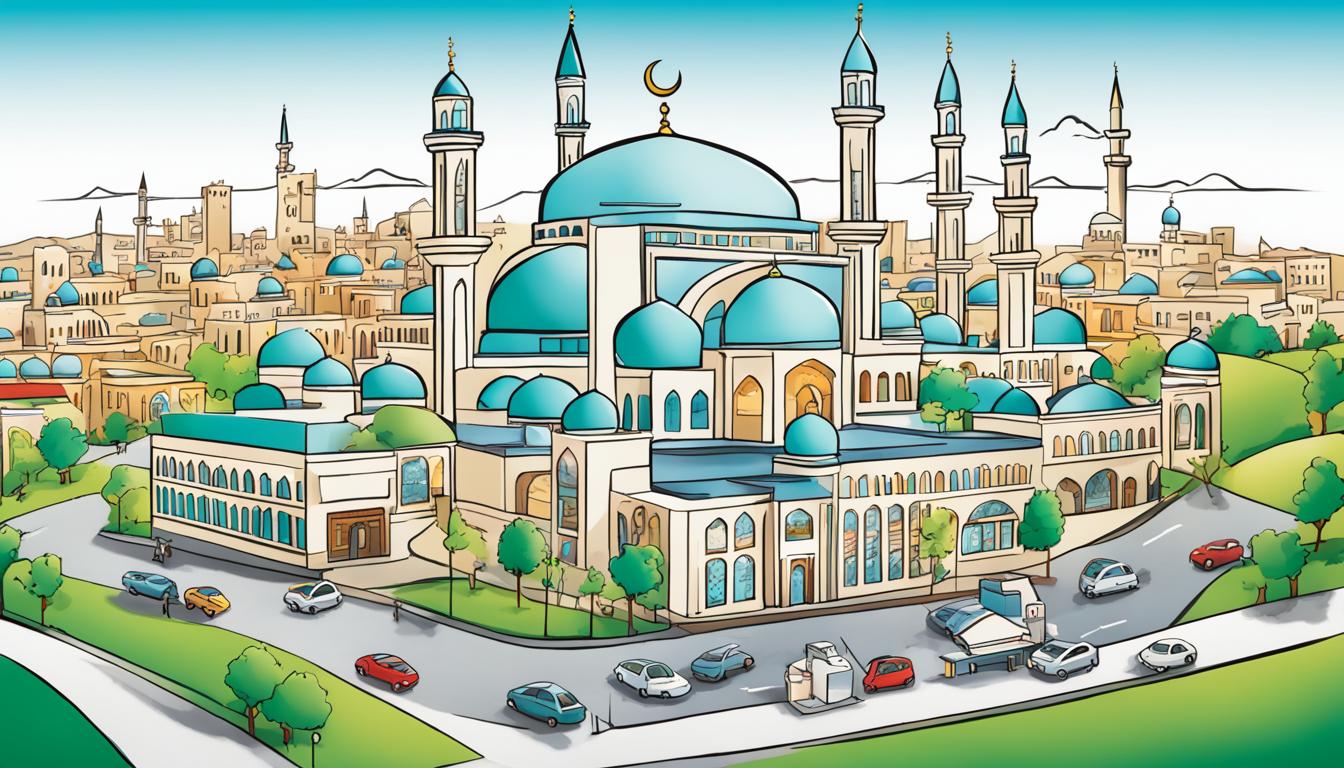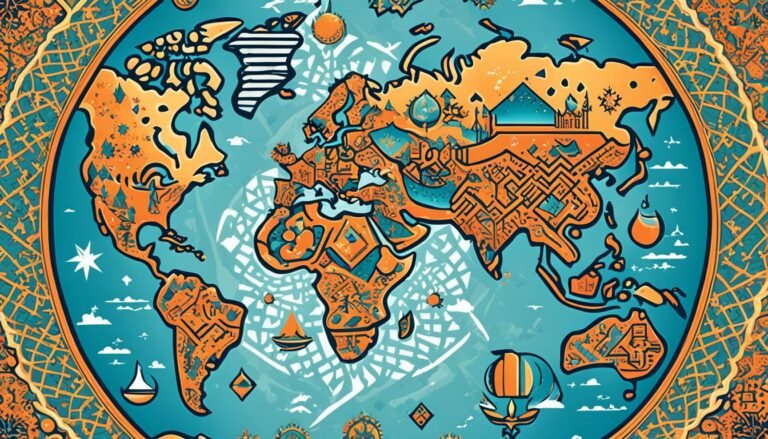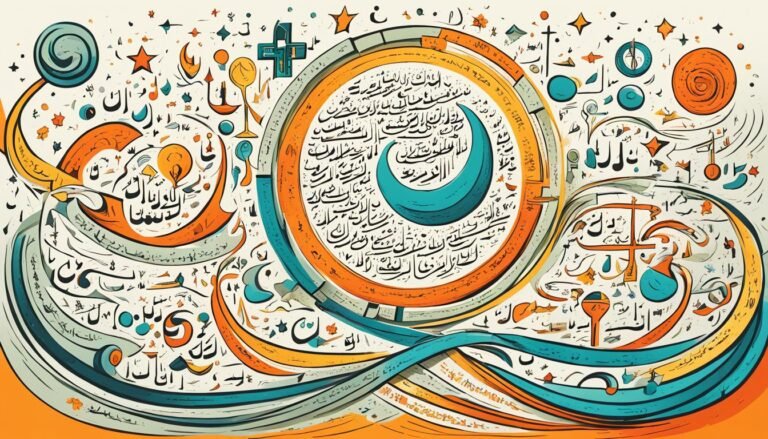Islamic Education: Reforming Curricula for Modern Needs
What if the future of Islamic Education is not just about sticking to old ways? What if it’s about changing the way we teach to fit today’s fast-paced world? As we look at education in a global community, mixing modern issues with Islamic teachings is key. This piece looks into why changing the curriculum in Islamic schools is a must. It’s about making sure they keep up with today’s world while still holding onto Islamic values.
We’ll look at the past, see what’s happening now, and find new ways to improve education. This could lead to better learning outcomes and more chances for students to move up in life through Islamic Education.
Key Takeaways
- Reforming curricula is essential for aligning Islamic Education with modern societal needs.
- Innovative educational strategies can enhance job opportunities for students.
- Islamic Education must maintain core religious values while adapting to contemporary challenges.
- Historical context plays a vital role in understanding the evolution of Islamic curricula.
- The future of Islamic schooling lies in integrating modern sciences and technology into teachings.
Introduction to Islamic Education
Islamic education is key in Muslim societies. It helps people grow spiritually and intellectually. At its heart, it uses texts like the Quran and Hadith. It teaches that seeking knowledge is crucial.
This education aims for a complete growth of the person. It covers spiritual, intellectual, and physical aspects. This way, students become well-rounded.
To get students ready for today’s world, Islamic studies need new approaches. Old methods focused too much on memorizing texts. This made it hard for students to think critically.
So, there’s a need for new curricula. They should mix modern subjects with religious studies. This makes learning more interesting and relevant.
Islamic schools are now reaching out to students from all over the world. They’re adding subjects like foreign languages and natural sciences. This makes the education more diverse while keeping religious values.
This change is because of globalization and economic changes. Islamic education is adapting to meet the needs of today’s society. It’s becoming more inclusive and dynamic.
By adopting these changes, Islamic education keeps its cultural and religious roots. It also prepares students for today’s world. As education evolves, combining old teachings with new knowledge is more important than ever.
Importance of Islamic Education in the Modern World
Islamic education is key in today’s society. It helps in the development of a nation and boosts economic progress. Studies show that focusing on education, especially Islamic teachings, leads to big improvements in society.
More schooling means higher earnings, as the World Bank found. The United Nations Development Program also found that more education leads to a 3.6% increase in GDP per capita. Countries with strong education systems are often leaders in innovation, as seen in the Global Innovation Index.
There’s a link between education and innovation. Nations like Finland are known for their innovation, thanks to their top-notch education.
- Education as the “great equalizer” significantly influences:
- Economic growth
- Social cohesion
- Health outcomes
- Innovation
It’s important to blend traditional Islamic education with modern teaching methods. We need to focus on evidence-based practices and improve our curriculums. Online Islamic education is changing how young people connect with their faith, offering both chances and challenges.
We must modernize Islamic education to meet today’s needs while staying true to Islamic values. This way, Islamic education can help build a society of informed citizens. They will be ready to contribute to the development of a nation and push economic progress.
Historical Context of Curriculum Development in Islamic Schools
The history of Islamic Education has seen big changes, especially in how we develop curriculums. Early on, Islamic schools focused on memorizing the Quran and following religious teachings. But, as time went on, new ways of teaching came along, bringing in ideas from the West.
In Indonesia, the school curriculum has changed a lot over the years. These changes happened in 1947, 1952, 1964, 1968, 1975, 1984, 1994, 2004, and finally in 2013. Each update aimed to make sure Islamic Education stays relevant today while keeping its religious roots. This shows how Islamic schools around the world have evolved.
Important people like Muhammad Abduh helped shape these changes. He believed in teaching modern sciences and Islamic teachings together. Scholars say good Islamic education should help students grow in both spirit and mind, mixing Quranic teachings with the world of science.
- The curriculum aims to improve students in spirit, mind, and body.
- It sets goals for knowledge, understanding, applying skills, and shaping attitudes.
- Some worry that globalization is affecting the true nature of Islamic education, causing a debate between keeping traditions and moving forward.
Islamic Education has gone through many changes over the years. The third phase saw a drop in Arabic and scientific studies, while the fourth phase brought in Western educational ideas. This led to the creation of different types of schools like madrasah, kuttab, and pesantren, each adding its own flavor to education.
Today, there’s a lot of talk about making education better in Islamic schools. Scholars and those who work in Islamic Education are discussing how to keep up with the world while staying true to Islamic values. They want to make sure future generations can succeed in a global society.
Current Trends in Islamic Education Reform
Recent changes in Islamic education show big shifts towards modernizing. It’s key to look at the Current Trends in this field. A two-day conference at Selwyn College, University of Cambridge, focused on educational reform. Scholars from over 15 countries came together to share ideas on how Islamic education can adapt for today’s world.
The conference covered important topics for Educational Reform. They talked about Islamic education in diverse societies, teaching citizenship to Muslim students, and using children’s literature in Islamic teaching. These talks showed a vision for Contemporary Education that values everyone’s background and diversity.
In countries like Indonesia, Islamic education is changing to include more cultures and technology. As the world gets more connected, new ways of teaching are coming up. The Current Trends show these changes aim to update Islamic education while keeping its core values.
- Integration of modern subjects such as mathematics and science.
- Emphasis on holistic moral and ethical development.
- Utilization of new teaching methods influenced by global educational practices.
These trends show the need for Islamic education to stay relevant and help individuals and society. The conference’s insights highlight the importance of keeping core Islamic values in Contemporary Education. Finding a balance between tradition and new ideas is key for Islamic education’s future.
Islamic Education: Reforming Curricula for Modern Needs
Islamic schools are changing to meet the needs of today’s world. They are updating their curricula to tackle the challenges of modern society. A 2011 conference at Selwyn College, University of Cambridge, brought together experts from over 15 countries. They shared how Islamic education can meet modern demands while keeping its core values.
One key change is adding modern sciences to the curriculum. Schools in Indonesia and Malaysia show how well traditional Islamic education and modern science can work together. These reforms aim to give students a well-rounded education that includes spiritual growth and academic success.
At the conference, topics like Islamic education in diverse societies and challenges in Islamic schools in the West were discussed. These talks highlighted the need for curricula that prepare students for today’s world. They also talked about citizenship education, which helps students fit into their communities better.
Even with these reforms, there are still challenges. Some people have negative views of Islamic schools, especially about their graduates. To change this, it’s important to show how these schools teach both Islamic values and modern knowledge.
| Region | Key Contributions | Percentage of References |
|---|---|---|
| Malaysia | Significant scholarly influence on Islamic education | 26.7% |
| Lebanon | Rich educational tradition in Islamic studies | 22.2% |
| United States | Growing interest in Islamic education | 11.1% |
| Turkey | Less dominant presence in scholarly works | 2.8% |
| Pakistan | Focus on madrasa reforms | 2.8% |
| Global Contributions | International collaboration and research efforts | 5.6% |
As Islamic schools balance tradition with modern times, reforming their curricula is key. By mixing secular and Islamic subjects, students become well-rounded. This change shows that Islamic education can evolve while keeping its core beliefs.
Integrating Modern Sciences into Islamic Curriculum
Adding modern sciences to the Islamic Curriculum is a big change in education. It blends today’s learning values with Islamic teachings for a new way of learning. Schools worldwide see the value in subjects like technology, programming, and environmental sciences. These subjects help students succeed in today’s fast world.
Programming is now seen as a key skill in many schools. When religious schools add modern subjects, students do better in school. They get better at thinking critically and solving problems.
Schools like those run by Muhammadiyah in Indonesia lead in this change. With over 3,300 schools, they mix religious education with modern subjects. This way, students learn a wide range of things.
When making curricula, teachers must keep Islamic values in mind. This approach helps students stay connected to their culture and ready for today’s challenges. It’s important for students to learn about new technologies while keeping their spiritual and ethical values.
Learning modern sciences in an Islamic setting prepares students for top careers. Starting with these subjects early builds a strong base for learning and adapting throughout life. Changes in education that focus on this will shape the future of Islamic learning. It will make sure the next generation is both smart and capable.
Pedagogical Innovations in Islamic Schools
Pedagogical innovations are key to improving Islamic school education. They bring new Teaching Approaches that make learning fun and complete. By using hands-on learning and group projects, students get more involved in their studies.
The book “Supporting Modern Teaching in Islamic Schools” is a great guide for teachers. It covers 302 pages and talks about how to teach better and update the curriculum. It starts by teaching teachers about the basics of good teaching and what to include in the curriculum.
Then, it talks about how teachers should keep learning and growing. It says teachers need to keep up with new ways of teaching, especially in Islamic schools.
- Cultural reinvigoration enriches the curriculum.
- Developing Islamic Education makes the curriculum better.
- Reform initiatives aim to mix new teaching methods with old values.
The last part looks at how to make the Islamic curriculum better. It shows why it’s important to make sure the knowledge taught is relevant today. Scholars from all over share their views, showing the challenges in teaching in Muslim countries.
Teachers are key to creating a supportive classroom. They use successful teaching methods to help students work together. This means changing old ways to better fit what students need.
| Component | Element | Outcome |
|---|---|---|
| Experiential Learning | Hands-on activities | Increased student engagement |
| Collaborative Projects | Group assignments | Enhanced teamwork skills |
| Professional Development | Ongoing training programs | Improved teaching quality |
Finding the right mix between new teaching methods and traditional Islamic Education is vital. There are challenges with these new ways, but they can be overcome with better teaching methods. These methods respect Islamic values and answer today’s needs.
The Role of Technology in Islamic Education
Technology has changed how we learn, especially in Islamic Schools. Digital tools are key in making learning fun and flexible. They help students get knowledge in new ways and make learning more engaging.
E-learning platforms are a big part of this change. They let teachers and students talk in real time. This creates a place where everyone can work together.
A study looked at 70 teachers and found that those with more experience face challenges with e-learning. But, gender and qualifications didn’t affect how much technology they used. This shows that technology is used the same way by all teachers.
More people want to learn, so we need new ways to teach. E-learning lets students learn at their own speed. Schools are moving from old madrasah settings to new, local ones. This change focuses on observing, reasoning, and applying what you learn.
To make digital learning work well in Islamic education, we need to use different teaching methods. This includes exploring and talking about what we learn. A supportive classroom helps students not just learn, but use what they learn in real life.
Checking how well we’re doing is key. It helps us see what’s missing and how we’re doing towards our goals.
Challenges Facing Islamic Educational Institutions
Islamic schools face many challenges that make it hard to reform education. Communities often resist change, mixing old values with new ones. This can make it hard to blend secular and religious studies together.
Money is a big problem for many Islamic schools. They don’t have enough to update their buildings and teaching methods. This means they can’t get the technology that schools need today. Plus, the media’s negative views on these schools make things worse, causing people to distrust them.
In Indonesia, schools like Muhammadiyah try to mix Islamic values with modern learning. But, they struggle to keep up religious studies as they focus more on general subjects. This makes it tough for teachers to prepare students for today’s world while keeping their faith strong.
In Pakistan, the Madrassah system has grown a lot. Now, there are about 45,000 Madrassahs, mostly for poor families. But, many of these schools teach extremist views, which can lead to radicalization. The country’s small education budget makes it hard to improve education quality everywhere.
Islamic schools need new ideas and a commitment to change to overcome these challenges. Working together, teachers, leaders, and policymakers can help. This way, they can create a place where Islamic values and modern learning go hand in hand.
Global Perspectives on Islamic Education Reform
Islamic education is changing all over the world. Countries are updating their Islamic Education Reform to fit today’s needs. They want to change how they teach to meet new demands and fix old views of madrasa education.
Now, there’s a big move to cut down on old religious teachings. Instead, they’re adding more instrumental-secular studies. This change helps madrasa graduates get the skills they need for jobs today. It also helps break down old stereotypes that came up after 9/11.
In places where madrasas are common, they’re adding subjects like math, science, and computer skills. This makes students more ready for jobs. It shows how looking at Comparative Studies can help us learn from other schools around the world.
How much the government affects Islamic education also changes a lot from place to place. This affects how reforms happen and what’s taught.
Working together to update Islamic education is key. Countries are sharing good ideas and new ways to teach. This teamwork helps students see the world from different views while keeping their own culture.
Nations are working hard to change Islamic education for the better. Talking about Global Perspectives on these changes helps everyone learn. It also gives schools new ways to teach, making sure students can handle today’s world.
Conclusion
The growth of Islamic Education is key to meeting the future needs of learners in our diverse and competitive world. This article showed how adding modern sciences and new teaching methods can improve Islamic curricula. It helps students get a full education while keeping their cultural and religious roots.
Changing Islamic Education is vital to meet the challenges of globalization and new technology. It’s important to mix old values with modern needs. By adding foreign languages, natural sciences, and critical thinking, students can face the future’s challenges.
The path to a better Islamic education system is ongoing and full of chances for growth. It needs teamwork from teachers, policymakers, and communities for a complete education plan. This change is important for better education results and for making people ready for a fast-changing world while keeping their Islamic beliefs.
Source Links
- No title found
- Introduction to Part II: Islamic Education in the Modern Era: Social, Cultural, Political, and Economic Changes and Responses from Islamic Education
- Religions
- The Modernization Concepts of Islamic Education, According to Azyumardi Azra
- Curriculum development in Islamic perspective
- Reforms in Islamic Education | Centre of Islamic Studies
- The programming curriculum within ISIS
- A holistic-integrative approach of the Muhammadiyah education system in Indonesia
- Microsoft Word – Abdula Paper FINAL 5-22-06 _4_.DOC
- Supporting Modern Teaching in Islamic Schools: Pedagogical Best Practice for Teachers
- Islamic Religious Education Curriculum Development Model
- Microsoft Word – wje-v12n4-neiye
- INNOVATION IN ISLAMIC EDUCATION | Hayula: Indonesian Journal of Multidisciplinary Islamic Studies
- Progressive Islamic Education: Bridging the Gap of Islam, Indonesianness, and Modernity
- Pakistan’s Madrassahs: Ensuring a System of Education not Jihad | Brookings
- Does Religious Education Have a Future in 21th Century? An Anthropologist on the Continued Relevance of Islamic Education
- Reforms in Islamic Education: International Perspectives by Tan, Suleiman New-, 9781441101341 | eBay
- Islam and Education in the Modern Era: Social, Cultural, Political Changes and Responses from Islamic Education
- Microsoft Word – 03_JPPI_Vol 11 No 2 2023







